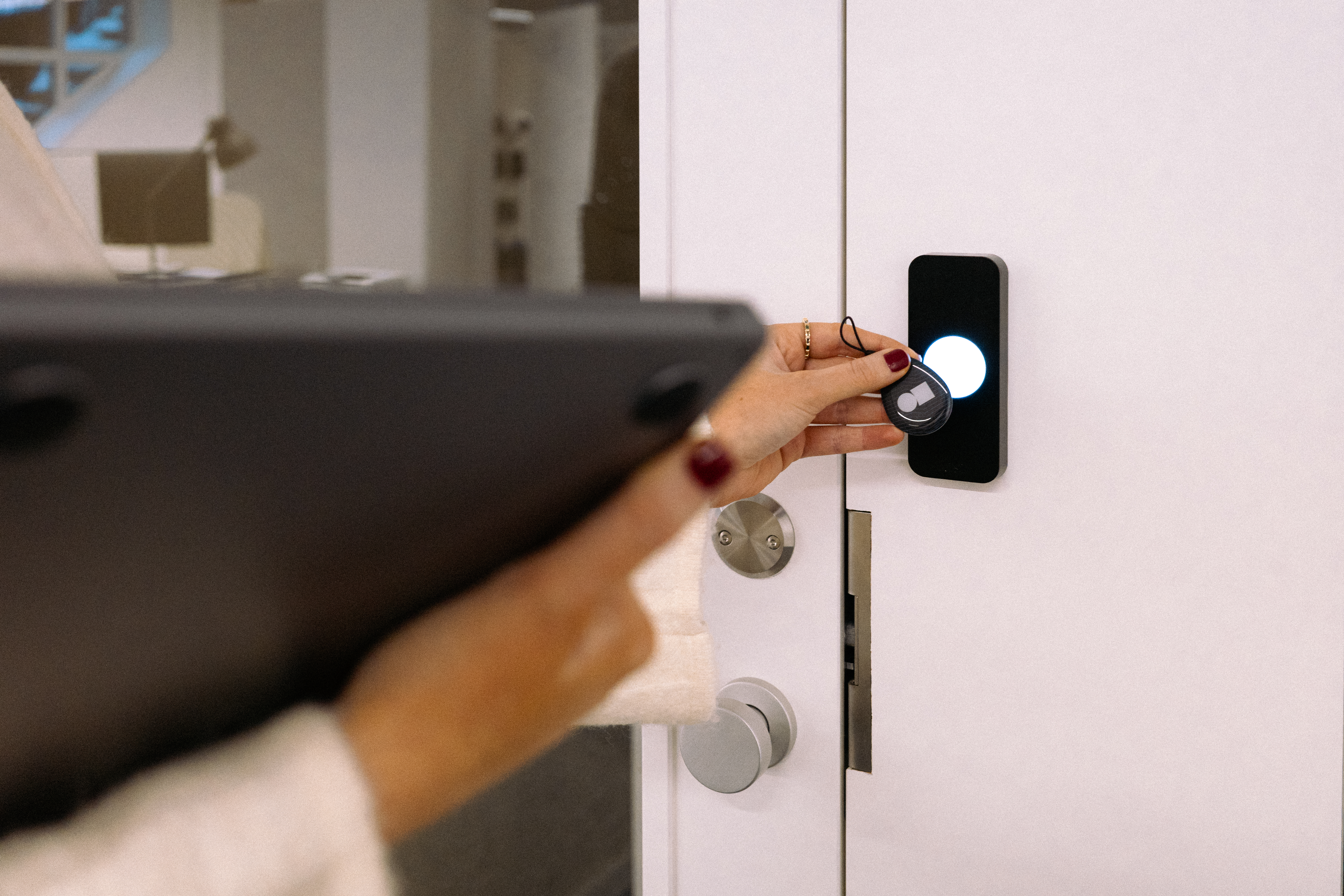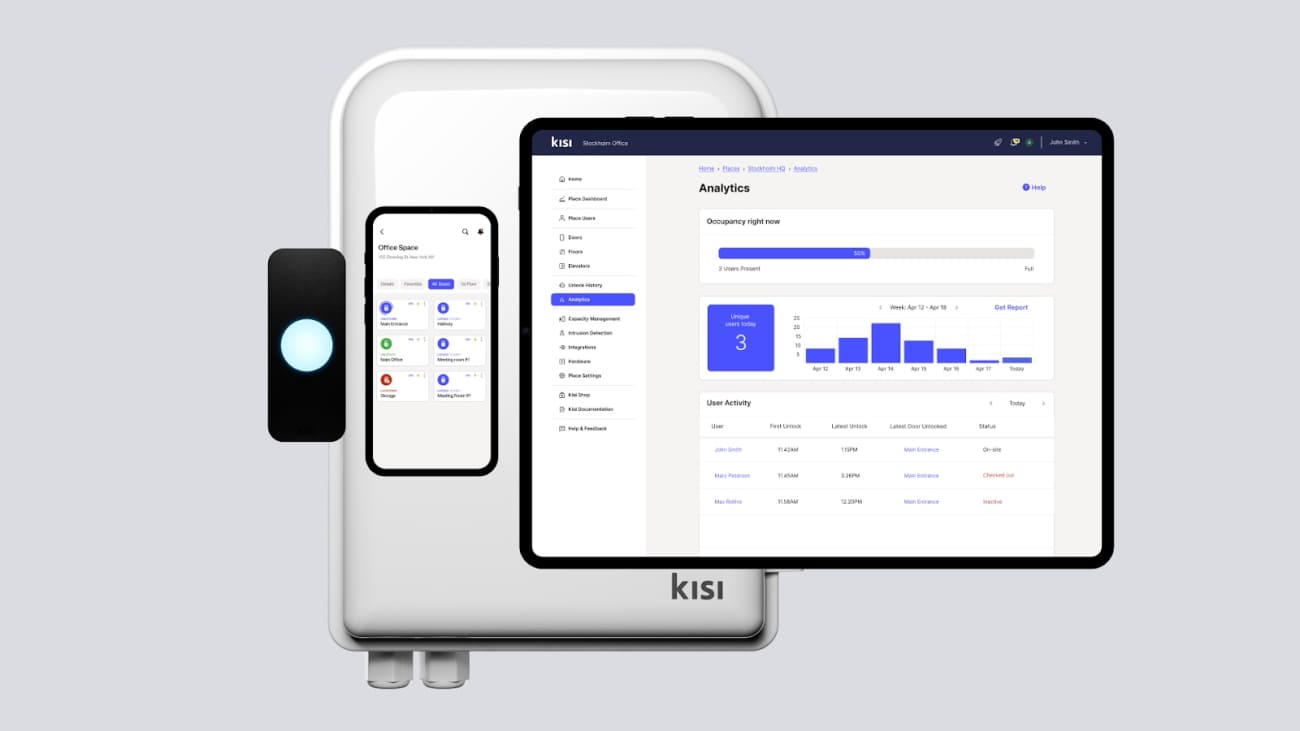Using physical keys to unlock every door is no longer the go-to practice, with electronic locking systems emerging as an easier and more manageable alternative. One of the options businesses can consider when looking for a more modern approach to security and access control is an RFID locking system.
RFID systems are a common choice for commercial real estate because they increase security while also allowing for hands-free access. Their growth also coincides with the public’s increasing preference for faster and simpler ways to unlock doors, such as mobile access.
This article explores the technology behind RFID locks, what types of solutions are available, and what’s drawing people to them. It also outlines steps you can take when choosing an RFID lock system provider for your property.
What is an RFID locking system? #
A radio frequency identification (RFID) locking system is an electronic system that allows you to secure doors and grant access without physical keys. It’s a popular technology for commercial and residential real estate, particularly multi-tenant buildings. You can use RFID locks to secure a primary entrance or specific areas within your building, such as elevators and parking garages.
How RFID locks work #
An RFID door lock system uses electromagnetic waves to transmit and receive data. Rather than physical keys, users have key cards, fobs, or other items with embedded RFID chips or tags that activate when they’re near a reader. If the individual has the required credentials to enter the space, the information transmitted to the reader triggers the door to unlock. If the user doesn’t have authorization, they will be denied access.

Comparing RFID and NFC locks #
It’s easy to confuse NFC and RFID locking systems because they’re both commonly used for access control. However, they’re based on different types of technology and thus have unique applications.
The distinctions between RFID and NFC access control systems begin with how they communicate. NFC, or near field communication, is a two-way communication technology, whereas RFID is one-way. This means that NFC tags can generally receive and send information, while many RFID tags only do one or the other.
Reading range is another important difference. RFID tags can transmit waves over much longer distances, making them appropriate for a broader range of applications, such as supply chain management and inventory tracking, as well as access control. NFC’s range is significantly shorter, often only a few centimeters. As a result, it’s generally a safer option when implementing access control for high-security locations.
Components of an RFID lock system #
RFID locking systems consist of several parts that work together to secure your space. Specifically, this type of system requires:
- A reader that emits radio waves to communicate with embedded tags or chips
- A controller that connects to the reader and reads data transmitted from the door system
- Credentials, such as key fobs or cards, with RFID tags carrying the information that prompts the lock to open
- Electronic door lock mechanisms that unlock in response to the user’s credentials
All these components must be present for an RFID locking system to work effectively. A typical implementation might look like this:
You place a reader at the front and back entrances to your building. Employees carry key fobs or smartphones equipped with the necessary technology. When an employee approaches the front entrance and presents their credentials at the beginning of their workday, the information transmits to the reader, which sends it to the controller for authorization, and the door appears to unlock automatically. After passing through the door, it relocks behind them to prevent other individuals from entering without authorization.
Types of RFID door lock systems #
Variations of RFID door locking systems are available to meet the needs of different types of businesses. Knowing what kind of system to look for is an important first step if you’re considering making the change to this technology.
Active vs. passive systems #
Understanding the differences between active and passive RFID systems is crucial to ensuring that you implement a solution that’s right for your business. Passive RFID tags don't have an internal power source and rely on energy from the reader to transmit data, while active tags have their own battery, allowing them to transmit data over longer distances.
In most cases, passive systems are a better fit for commercial properties. They’re less expensive, smaller, and generally more secure.
Active systems, on the other hand, use more advanced technology and have a very long reading range compared to passive ones. That, coupled with their dedicated internal power source, makes them less affordable for most businesses. Active RFID locking systems are often used in tracking and identifying vehicles rather than granting access to individuals entering buildings on foot.

Frequency types #
Another point to remember when looking at an RFID door lock system is which frequency level it uses:
- Low-frequency: These systems have a much shorter read range—usually a few centimeters—so users have to place their credentials in close proximity to the reader to gain entry.
- High-frequency: A high-frequency RFID system can detect users while they’re still several feet away and is sometimes compatible with NFC-enabled devices.
- Ultra-high: Ultra-high systems offer the quickest read times and longest ranges, but they can suffer from interference as a result.
In commercial applications, low-frequency RFID systems are a popular choice for building entrances and office doors. In contrast, ultra-high frequency systems are common in parking garages and gated communities because they can detect credentials for approaching cars.
Benefits of using an RFID locking system #
RFID technology isn’t a perfect solution for every building or business. However, it offers several advantages that are worth noting:
- Ease of use: Because an RFID lock system is triggered by proximity, it’s easy for anyone to use. Users don’t have to make physical contact with the reader, making it much more convenient for employees to gain access when their hands are full.
- Simplified access management: When using traditional locks, building managers and business leaders have to assign, track, and collect keys. RFID systems are electronic, so you can adjust, cancel, or grant privileges digitally without having to keep up with keys or change locks.
- Data gathering: In this new and continuing era of hybrid work experiences, knowing who is entering and exiting a building or space at any given time is crucial to optimizing your space utilization. The ability to track movement through entrances also helps identify and understand issues with employee performance or attendance.
- Improved security: According to a 2024 survey, 25% of businesses are seeing an increase in physical security incidents. While it’s not usually ideal for high-security applications, an RFID locking system can reduce the risk of unauthorized entries and intruders for lower security organizations, especially when compared to regular locks.
Keep in mind that some of these benefits are also available through other technology. Carefully evaluate all your options, such as NFC readers, before committing to a locking system.

How to choose an RFID system #
Selecting an RFID door lock system can be difficult if you’re not familiar with your options. Follow these steps to get started.
Assess your security needs #
Think about what areas of your building would benefit the most from having an RFID locking system. For example, is there a space that only employees, rather than guests and visitors, should be allowed to access? In addition, consider whether you have concerns about tailgating or interference. These issues can help you determine if an RFID system is appropriate for your space.
Research compatibility with existing systems #
Combining your RFID locks with other systems and tools, such as video surveillance cameras, allows you to take a more unified approach to safety and management. Before purchasing a solution, investigate whether you can integrate it with your security systems and devices, such as surveillance cameras. Using an RFID door lock system with Kisi enables you to monitor your premises and respond quickly to illicit activity, such as an attempted break-in or property damage.
Break down your budget #
Pricing is a concern for many businesses searching for a new door locking system, but it’s important to look at the big picture when it comes to expenses. Examining the price of your initial purchase and deployment is wise, but don’t stop there. Calculate the approximate cost of ongoing maintenance and operational expenses, such as tag replacements, system updates, or ongoing technical support. If you’re looking to migrate your current access control system explore possible deployment options.
Consider the provider’s reputation #
No one outside your organization can say for certain whether a particular RFID locking system is the right choice. However, you can gain valuable insights by looking at the provider brand’s reputation and reviews. In addition to reading any praise or complaints about the technology itself, it’s also useful to see what people have to say about the company’s customer support. This gives you a better idea of whether help will be available if you encounter issues in the future.
Upgrade your door locks and access control #
Like every solution, RFID door locks have some notable disadvantages, including concerns about interference and cloning credentials. However, advances in RFID technology will likely lead to more durable tags at more cost-effective prices. As these door lock systems continue to evolve, experts project that the global market will reach $13.6 billion by 2030, increasing from $4.4 billion in 2022.
When you’re ready to migrate to a more secure, up-to-date door locking system, remember that choosing a modern, cloud-based access control solution enables a cohesive system that protects your building and its occupants. Kisi’s future-proof access control solution is easy to use and compatible with RFID technology. Book a demo to see what Kisi can do for you.


